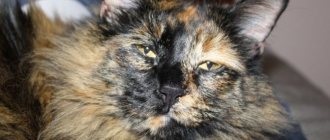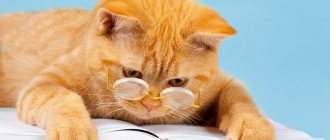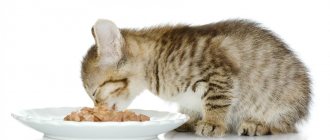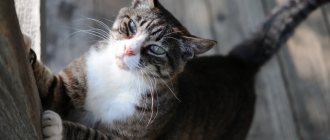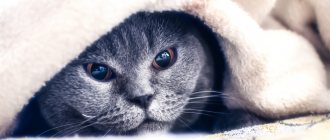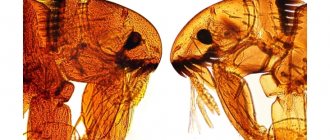Why does a cat need mustaches and eyebrows?
Why does a cat need whiskers? They are an important organ of touch. Many animals that feed on their mother's milk have similar adaptations.
The hardest and longest whiskers of a cat help the animal navigate in space. These hairs are located on the cheeks, on both sides of the nose, above the eyes, on the chin and tail.
Such whiskers perform an important function due to the fact that there are sensitive endings at the tip of each whisker. The function of the whiskers is to transmit information about the surrounding world to the pet’s brain. This is how the cat knows when an obstacle or prey appears in its path.
What are whiskers called on cats?
Cat's whiskers also have another name that is not known to everyone. Scientifically, they are called vibrissae. Cats touch different objects with them to determine their size. For example, before climbing into a hole, a cat checks with whiskers whether it is of sufficient size.
Do hairless cats have whiskers?
The pet may not have them at all. Due to the nature of the breed, hairless cats may have broken whiskers, curled or not have them at all.
Sometimes the absence of vibrissae occurs in furry representatives of the cat family. This is due not only to the breed, but also to a kind of mutation.
Whiskers on a cat's paws and nose
As already mentioned, the whiskers of cats are located not only on the face, but also on the paws and tail. How many whiskers a cat has along the body depends on the breed and the specific representative.
The longest hairs on the nose reach seven centimeters. The Book of Records has registered a Maine Coon cat in Finland with whiskers nineteen centimeters long. Another Russian cat had a slightly shorter whisker length - only 13.5 centimeters.
The whiskers on the paws and tail are not so long; they can be distinguished by their greater rigidity. The number of rows of a cat's whiskers determines how well they navigate the world around them.
Why does a cat lose its whiskers?
Before becoming interested in the question of whether cats grow whiskers, owners are faced with the fact that the cat loses them. And there are several reasons for this :
- The most common one is a curious child who gives the cat a haircut. Most likely, the baby will be confident that the mustache will grow very quickly and this procedure will not harm the cat. It is important to tell your child in time about the danger to your pet’s health from the loss of such an important sense organ.
- Carelessness in carrying out hygiene procedures by the cat owners themselves. Sometimes it happens that the owner himself cuts off the whiskers, for example, during cutting out hairballs and similar procedures, when the cat is actively trying to escape and involuntarily exposes its whiskers.
- Vitamin deficiency also quite often leads to the fact that the mustache becomes too thin, brittle and falls out completely. After taking vitamins, they grow back stronger, thicker and the cat returns to normal.
- Allergic reaction. The reason, although not frequent, does occur. The faster the source of the allergy is identified and eliminated, the faster the cat's whiskers grow.
- Diseases such as diabetes, problems with the thyroid gland, endocrine system, and lichen lesions of the skin also lead to loss of mustache. With proper treatment, the vibrissae grow back quite quickly.
© shutterstock
Why does a kitten's whiskers break?
If a pet's whiskers, especially small ones, break off, this can cause anxiety for the owners. The reasons for this phenomenon may be different:
- a cat's whiskers break during adolescence;
- when the balance of minerals in the body is disturbed;
- the reason may be the presence of worms or fungal infections in the pet’s body;
- damage to the vibrissae during play;
- Sometimes the antennae of small kittens are broken by mother cats to prove their authority to the kittens.
The reason could also be that the kitten is too curious - it came too close to the fire or met another animal.
Adult cats and male cats also often lose their whiskers; this may be due to the following factors:
- An allergic reaction to an external or internal irritant.
- A cat loses whiskers if the air in the room is too dry.
- Vibrissae can break due to hormonal imbalance or improper functioning of the thyroid gland. In this case, the cat may be left without a whisker altogether.
- A cat's whiskers split if it eats the wrong or unbalanced food.
- Domestic cats lose their whiskers due to kidney problems and dehydration.
What to do to stop vibrissae loss
First of all, if your cat's whiskers are falling out, you should take him to the vet for an examination. The doctor will examine the pet and, if necessary, prescribe appropriate tests. Only after the reason why the cat’s whiskers break is determined, treatment is prescribed.
As a rule, in case of hair loss, the animal is prescribed anti-parasitic drugs, anti-allergenic drugs, antibiotics, and vitamins. You will also need to normalize the pet’s living conditions, change the cat’s diet, and, if necessary, increase the air humidity in the house.
What functions does the mustache perform?
In dogs, the whiskers, or vibrissae, act as a “sixth sense”. The follicles at their base are vascularized, that is, connected to nerve endings that send signals to the animal's brain.
The whiskers protrude from the skin and act as a lever through which the dog receives external stimulus. The information is sent to the follicle and then transmitted to the animal's brain, allowing it to decode the signal and generate a response.
Whiskers in dogs perform the following functions:
- help measure distance in the dark. Air currents perceived by the whiskers give the dog an idea of the size of the room, house, as well as the location of objects in relation to the body.
- read the temperature and wind speed, feeding the information into the dog’s brain.
- vibrissae located above the eyelids work on the principle of eyelashes, that is, they protect the dogs’ eyes from dust and dirt in the air.
Few people know, but a dog’s whiskers are proportional to its body. Thanks to this, the animal is able to predict how wide or narrow the space in front of it is and whether it can pass.
Why do cats' whiskers turn black or white?
The color of the whiskers directly depends on the color of the animal itself. They can be white, black, red or several colors at the same time. Usually a black cat has black whiskers, but sometimes white whiskers are normal. In some breeds they turn black over time.
If a cat with a white mustache has acquired a black color, this phenomenon also does not mean anything terrible, just a normal change in hair pigmentation. You should be wary if the color, on the contrary, changes to white. Sometimes this can be a symptom of a disease. Therefore, even with a slight deviation, it is worth consulting with a veterinarian.
Why doesn't my mustache grow?
Many guys who decide to grow facial hair are upset if after a week without shaving there is no change. It’s worth noting right away that it won’t be possible to grow it in a few days or even weeks. But, if it is noticeable that even after a month no changes have occurred, then we are talking about pathologies of a dermatological or hormonal nature.
Therefore, if you want to see a beautiful mustache on your face, but it is not growing, the first thing you should think about is the help of professionals. There are several reasons for the absence; it is not always a pathology. Often stubble does not grow due to heredity. Pay attention to your male relatives. If they have no hair under their nose, you shouldn’t expect that you will have a beautiful and thick mustache a month later - it’s difficult to do anything against genes.
Teenagers have unstable hormonal levels. Testosterone levels fluctuate, so you shouldn’t expect active hair growth simply because the hair follicles on your face have not yet become active. You shouldn't use special products either - you need to wait a little to grow a mustache.
Does your dad have a mustache?
YeahNo
Let's look at the stages of hair growth to have a clear idea of how it grows. This will help you understand when you need to start growing vegetation, and whether it is worth doing it at all.
- Bristle . The first stage, at which it is already clear whether you will be able to grow a thick mustache. Forget about the razor for two weeks. If you see that they are growing slowly and there are bald spots, then it is best to abandon the idea of growing a mustache. If your mustache does not grow at all, try using professional shampoos, oils, and lotions. Hairdressers or barbers can recommend them to you.
- Three months . This stage is not easy, because at this time the stubble looks unkempt and creates an unpleasant appearance. Hair will grow faster in the center, and slower on the neck and cheeks. If you want to look neat, then during this period trim the hair on your Adam’s apple, and you also need to trim it in the cheek area. After eating, the hair above the lips should be washed thoroughly - it is possible that food particles will remain in them.
- Six months . This is exactly the period of time that must pass if you want to grow a mustache. They need to be looked after and trimmed regularly. To keep your hair soft and pleasant to the touch, it is important to use all kinds of balms. Vegetation can be trimmed by a special master - a barber. Then you will boast of a beautiful and thick mustache.
If in six months you still haven’t seen abundant facial hair, contact a cosmetologist. It will help eliminate the cause (if any). When the reason lies in genes, unfortunately, only surgery can correct the situation - hair transplantation from the head to the face. It is expensive and does not always pay off.
Many people are interested in how to speed up mustache growth. There are a variety of cosmetics specifically for this purpose. Also look at the pharmacy, or Google effective folk methods.
When the cause of poor facial hair is a lack of testosterone, the situation can be corrected. Change your lifestyle - play sports, switch to proper nutrition. You will have to give up alcohol and smoking, it is important to avoid stressful situations.
Interesting facts about mustaches
- The system of pressure on the antennae can create a feeling of anxiety in them, so use a wide plate or flat feeder to eat.
- In addition to a dozen hairs that are located on different sides of the nose, there are rather short analogues that are located near the eyes, near the chin, and on the other side of the paws in front.
- The size of the hairs is such that they are literally similar to the width of the body, so they can figure out the width of the holes for themselves without even trying to pass through it.
- The placement of the mustache can be balanced by different moods. If they are completely relaxed and straightened in different directions, then the cat feels calm. If they are turned forward, it means there is anxiety.
- Without whiskers, cats may become disoriented and experience headaches, thereby not receiving vital signals.
Is it possible to trim them?
Under no circumstances should the whiskers be trimmed; without this important sense organ the cat:
- unable to adequately assess the size of holes, will begin to get stuck in them;
- will often become disorientated and fall;
- will not be able to adequately assess the distance between objects.
It is known that sometimes a mother cat personally chews off the whiskers of her most active kittens so that they are calmer
Fortunately for cats, even if someone cuts their whiskers or they lose them in a fight or get burned, they will grow back after some time, like the rest of their fur. Problems with restoration can only arise when the follicle itself that holds the mustache is damaged.
